| Old Burying Ground | |
|---|---|
 | |
| Details | |
| Established | 1749 |
| Location | |
| Country | Canada |
| Coordinates | 44°38′36″N 63°34′22″W / 44.6434°N 63.5728°W |
| Type | Closed |
| Owned by | St. Paul's Church (Halifax) |
| No. of graves | 12,000+ |
| Official name | Old Burying Ground National Historic Site of Canada |
| Designated | 1991 |
| Type | Provincially Registered Property |
| Designated | 1988 |
The Old Burying Ground (also known as St. Paul's Church Cemetery) is a historic cemetery in Halifax, Nova Scotia, Canada. It is located at the intersection of Barrington Street and Spring Garden Road in Downtown Halifax.
History

The Old Burying Ground was founded in 1749, the same year as the settlement, as the town's first burial ground. It was originally non-denominational and for several decades was the only burial place for all Haligonians. (The burial ground was also used by St. Matthew's United Church). In 1793 it was turned over to the Anglican St. Paul's Church. The cemetery was closed in 1844 and the Camp Hill Cemetery established for subsequent burials. The site steadily declined until the 1980s when it was restored and refurbished by the Old Burying Ground Foundation, which now maintains the site and employ tour guides to interpret the site in the summer. Ongoing restoration of the rare 18th-century grave markers continues.
Over the decades some 12,000 people were interred in the Old Burial Ground. Today there are about 1,200 headstones, some having been lost and many others being buried with no headstone. Many notable residents are buried in the cemetery, including British Major General Robert Ross, who led the successful Washington Raid of 1814 and burned the White House before being killed in battle at Baltimore a few days later.
Commanders of three of the ships that served Governor Edward Cornwallis buried crew in unmarked graves: HMS Sphynx (1 crew), HMS Baltimore (1 crew) and HMS Albany (6 crew). HMS Sphynx was Cornwallis' own ship and the crew member was buried on the day his ship arrived in Halifax on 21 June 1749. HMS Albany was a 14-gun sloop commanded by Nova Scotia's senior naval officer, John Rous (1749–1753).[1]
There are four recorded Mi'kmaq buried in the burial ground, including a Mi'kmaw Chief Francis [Muis].[2] There was also a "protestant indian" named John Tray, possibly from John Gorham's rangers.[3]
There are also 167 recorded Black people buried in the graveyard, all with unmarked graves. (There is a grave marker, however, of the Huntingdonian Missionary who taught at the first school for Black students in Halifax, Reverend William Furmage.) Black people arrived with New England Planters. During the arrival of the Planters, there were 54 Black people in Halifax. 7 were buried in the cemetery from 1763 to 1775.[4] Black Nova Scotians also arrived in Halifax with Boston Loyalists after the evacuation of Boston in 1776. During this period, 18 Black people were buried in the cemetery (1776–1782). Seventy-three free Black immigrants (and no slaves) also arrived in Halifax with the New York Loyalists after evacuation from New York in 1783. Of the 73 who arrived from New York, there were 4 burials that happened during this time period. Rev. John Breynton reported that in 1783 he baptized 40 Black people and buried many because of disease.[5] Between the years 1792–1817 there are no recorded burials of Black Nova Scotians. The largest number of burials happen in the 1820s (72 graves), presumably the graves of the 155 Black Refugees who arrived in Halifax during the War of 1812.[6][7]
The last erected and most prominent burial marker is the Welsford-Parker Monument, a Triumphal arch standing at the entrance to the cemetery commemorating British victory in the Crimean War. This is the first public monument built in Nova Scotia and is the fourth oldest war monument in Canada. It is also the only monument to the Crimean War in North America. The arch was built in 1860, 16 years after the cemetery had officially closed. The arch was built by George Lang and is named after two Haligonians, Major Augustus Frederick Welsford and Captain William Buck Carthew Augustus Parker. Both Nova Scotians died in the Battle of the Great Redan during the Siege of Sevastopol (1854–1855). This monument was the last grave marker in the cemetery.
In 1938, the Grand Lodge of Massachusetts presented and dedicated a granite monument to Erasmus James Philipps, who is the earliest known settler of Nova Scotia (c. 1721) to be buried in the cemetery. He was also the founder of Freemasonry in present-day Canada (1737).[8]
The Old Burying Ground was designated a National Historic Site of Canada in 1991.[9] It had earlier been designated a Provincially Registered Property in 1988 under Nova Scotia's Heritage Property Act.[10]
Prominent tombstones

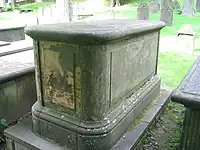


 Gov. Richard Philipps nephew Capt. Erasmus James Philipps monument, died 1760, unmarked grave, 40th Regiment of Foot, participated in the Battle of Grand Pré and the Cape Sable Campaign, Nova Scotia Council (1730–1760)[13]
Gov. Richard Philipps nephew Capt. Erasmus James Philipps monument, died 1760, unmarked grave, 40th Regiment of Foot, participated in the Battle of Grand Pré and the Cape Sable Campaign, Nova Scotia Council (1730–1760)[13]
 Grave of Sir Thomas Ussher's wife, Eliza Ussher, died 1835
Grave of Sir Thomas Ussher's wife, Eliza Ussher, died 1835 Grave of William Lawson's father and family
Grave of William Lawson's father and family
Notable interments
Founding of Halifax (1749–1776)
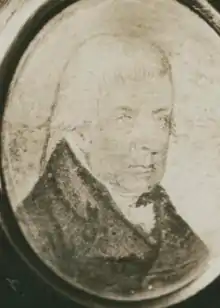 John George Pyke's father John Abraham, died 1751, scalped in Dartmouth massacre, unmarked grave[14]
John George Pyke's father John Abraham, died 1751, scalped in Dartmouth massacre, unmarked grave[14]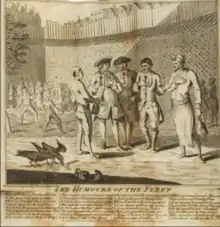 William Paget (Shakespearean actor), died 1752, unmarked grave
William Paget (Shakespearean actor), died 1752, unmarked grave John Rous' daughter Mary, died 1775 (Rous was in the Battle at Chignecto, Siege of Louisbourg (1758))
John Rous' daughter Mary, died 1775 (Rous was in the Battle at Chignecto, Siege of Louisbourg (1758)) John Connor (mariner), died 1757, involved in Attack at Mocodome
John Connor (mariner), died 1757, involved in Attack at Mocodome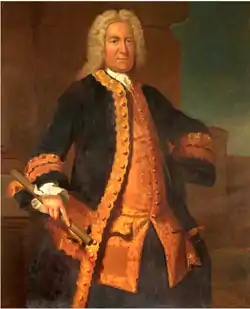 Gov. Richard Philipps's nephew Capt. Erasmus James Philipps, died 1760, 40th Regiment of Foot, participated in the Battle of Grand Pré and the Cape Sable Campaign, Nova Scotia Council (1730–1760)
Gov. Richard Philipps's nephew Capt. Erasmus James Philipps, died 1760, 40th Regiment of Foot, participated in the Battle of Grand Pré and the Cape Sable Campaign, Nova Scotia Council (1730–1760)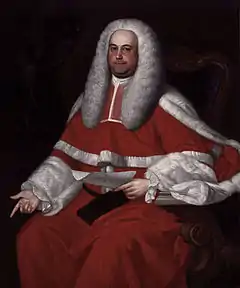 Jonathan Belcher (jurist), died 1776, participated in the Halifax Treaty with Mi'kmaq (1761)
Jonathan Belcher (jurist), died 1776, participated in the Halifax Treaty with Mi'kmaq (1761) Abigail Belcher, wife of Jonathan Belcher[15]
Abigail Belcher, wife of Jonathan Belcher[15]
 Catholic Priest Pierre Maillard was buried in the church yard.[17]
Catholic Priest Pierre Maillard was buried in the church yard.[17] Richard Bulkeley's wife, died 1775[18]
Richard Bulkeley's wife, died 1775[18]

- Mary Morris, wife of Charles Morris (surveyor general)
- James Brenton
- Honourable William Nesbitt
- John Fillis (belonged to St. Matthew's)
- Priscilla Ball, died 10 May 1791, Black servant, unmarked grave[19][20]
- Mi'kmaw Chief Francis [Muis/ Muice], died 16 February 1781, unmarked grave[21][20][22][23][24][25][26]
- Captain William Kensey (Kenzie, Kinsey), sloop Vulture (1753–1755), died 30 April 1755, unmarked grave – he engaged in two naval battles to stop supplies going to the French, Mi'kmaw and Acadians; the battles were against La Margarite and another against the 'Nancy and Sally'[27][28][29][30]
Siege of Louisbourg (1745)
Many of those who first established Halifax arrived from Cape Breton, which the British of New England occupied since their Siege of Louisbourg (1745). The following participated in the Siege:
 Benjamin Green, died 1772, served on the first Nova Scotia Council in Halifax (1749); signed Treaty of 1752 with Mi'kmaq[31]
Benjamin Green, died 1772, served on the first Nova Scotia Council in Halifax (1749); signed Treaty of 1752 with Mi'kmaq[31] Joseph Gerrish, died 1774; also wounded at the Battle of Grand Pre; signed Halifax Treaties with the Mi'kmaq
Joseph Gerrish, died 1774; also wounded at the Battle of Grand Pre; signed Halifax Treaties with the Mi'kmaq Winckworth Tonge, died 1792, also fought in Battle of Fort Beauséjour and Battle of the Plains of Abraham
Winckworth Tonge, died 1792, also fought in Battle of Fort Beauséjour and Battle of the Plains of Abraham
- Joseph Fairbanks, died 1790 (St. Matthew's)
American Revolution
Military figures
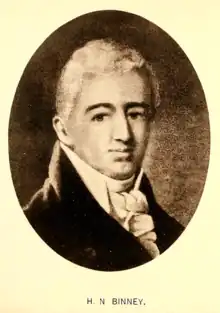 Hibbert Newton Binney, died 1842, painter, Ensign, Royal Nova Scotia Volunteer Regiment;[38][39][40] son-in-law of John Creighton (judge)[41]
Hibbert Newton Binney, died 1842, painter, Ensign, Royal Nova Scotia Volunteer Regiment;[38][39][40] son-in-law of John Creighton (judge)[41]%252C_Halifax%252C_Nova_Scotia.png.webp)
 Lt. John Stuart, died 1835 71st Regiment of Foot, Fraser's Highlanders, son-in law of Dr James Boggs[44][45]
Lt. John Stuart, died 1835 71st Regiment of Foot, Fraser's Highlanders, son-in law of Dr James Boggs[44][45]
- John F. T. Gschwind (died 1827), surgeon for Hessians; arrived in Halifax 1781[46]
- Charles Grant (military officer) (died 1785), 42nd Regiment of Foot – fought in the French and Indian War, Pontiac's War, and the American Revolution (New York and New Jersey campaign, the Philadelphia campaign, Battle of Stony Point, the Siege of Charleston, and the Siege of Yorktown), unmarked grave[47]
Boston Loyalists
The following were Loyalist refugees who settled in Halifax after they were banished from New York and Massachusetts. While most Loyalist came to the region from New York (over 66%), most of the Loyalists buried with grave markers are from Boston.[48] Reflective of the fate of many of the Loyalists, the grave of Edward Winslow (scholar) is inscribed: "his fortune suffered shipwreck in the storm of civil war." Part of the devastation of the war resulted from American family members having to choose sides. For example, the story of one American patriot listed below, Benjamin Kent. While in Boston he imprisoned his son-in-law Sampson Salter Blowers for being a Loyalist. Blowers and the rest of Kent's family (including his wife) escaped to Halifax (1776). After the war, Kent eventually moved to Halifax to be with his family, which included Chief Justice Blowers (1885). Both Blowers and Kent are buried in the Old Burying Ground.
_-_1978.606_-_Harvard_Art_Museums.jpg.webp) William Brattle, died 1776, the Attorney General of Province of Massachusetts Bay; "wealthiest man in Boston", silversmith, owner of William Brattle House, lost gravestone[49][50][51]
William Brattle, died 1776, the Attorney General of Province of Massachusetts Bay; "wealthiest man in Boston", silversmith, owner of William Brattle House, lost gravestone[49][50][51]_by_Copley.png.webp)

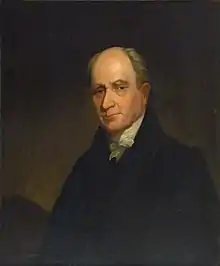 John Howe, died 1835, father of Joseph Howe
John Howe, died 1835, father of Joseph Howe.png.webp) John Halliburton (surgeon), died 1808
John Halliburton (surgeon), died 1808.png.webp)
 Loyalist Massachusetts Governor Thomas Hutchinson's brother Foster Hutchinson Sr., died 1799, Chief Justice of Province of Massachusetts Bay,[60][61][62][63]
Loyalist Massachusetts Governor Thomas Hutchinson's brother Foster Hutchinson Sr., died 1799, Chief Justice of Province of Massachusetts Bay,[60][61][62][63] Nova Scotia Gov. Paul Mascarene's grandchild Foster Hutchinson Jr., Chief Justice, died 1815,[64][65][66][67][68]
Nova Scotia Gov. Paul Mascarene's grandchild Foster Hutchinson Jr., Chief Justice, died 1815,[64][65][66][67][68]
 Chief Justice Sampson Salter Blowers, died 1842 – instrumental in ending slavery in Nova Scotia; son-in-law of Benjamin Kent
Chief Justice Sampson Salter Blowers, died 1842 – instrumental in ending slavery in Nova Scotia; son-in-law of Benjamin Kent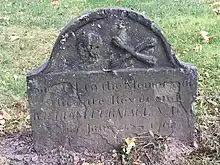 Reverend William Furmage (Firmage) (died 1793), Huntingdonian Missionary to the Black Loyalists; established first school for Black students in Halifax (1786)[70][71][72][73][74][75]
Reverend William Furmage (Firmage) (died 1793), Huntingdonian Missionary to the Black Loyalists; established first school for Black students in Halifax (1786)[70][71][72][73][74][75] Rebecca Byles Almon, died 1852, wife of William James Almon (surgeon, Battle of Bunker Hill); oldest child of Mather Byles[76]
Rebecca Byles Almon, died 1852, wife of William James Almon (surgeon, Battle of Bunker Hill); oldest child of Mather Byles[76]
- Governor Paul Mascarene's grandchild William Handfield Snelling, died 1838[79][80]
- Theophilus Lillie (died 26 May 1776), unmarked grave[81][57][82]
- Byfield Lyde, (died 1776) unmarked grave[57][83]
- John Lovell (loyalist) (died 17 July 1778), unmarked grave[57][84]
- Christopher Minot (died 1783), unmarked grave[57][85]
- George Brinley (died 1809), unmarked grave[57]
- Jeremiah Dummer Rogers (died 1784), unmarked grave[57][86]
- Archibald Cunningham (loyalist) (died 1820), unmarked grave[57]
- Benning Wentworth (loyalist), died 1808 provincial secretary of Nova Scotia[57]
- Capt. William Burton, 98th Regiment of Foot, died 1817 (Boston)
- Martha Howe, wife of John Howe, mother of Joseph Howe
- William Taylor, died 1810, a Boston merchant; father of James Taylor (Nova Scotia politician)[78]
- Peter Lennox;
- Jonathan Sterns, died 1798, killed by Attorney General Richard John Uniacke[57]
- Gilbert Stuart,
- Gregory Townsend[87]
- William Burton (merchant) (c. 1748–1817)[88]
- Sylvia (died 12 March 1824, age 70) black servant who resisted the American Privateers in the Raid on Lunenburg (1782)
Boston Patriot
 Benjamin Kent – lawyer who freed first slave in United States; First patriot Attorney General of Massachusetts
Benjamin Kent – lawyer who freed first slave in United States; First patriot Attorney General of Massachusetts
New York Loyalists
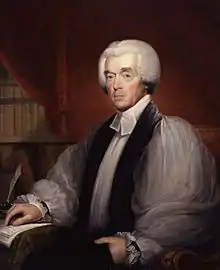 Bishop Charles Inglis' daughter Margaret (Inglis) Halliburton (and wife of Brenton Halliburton), advocated for education for Black Nova Scotians[78]
Bishop Charles Inglis' daughter Margaret (Inglis) Halliburton (and wife of Brenton Halliburton), advocated for education for Black Nova Scotians[78] Lawrence Hartshorne, died 1822, a Quaker who was the chief assistant of John Clarkson (abolitionist) in helping the Black Nova Scotian Settlers emigrate to Sierra Leone (1792)[89][90]
Lawrence Hartshorne, died 1822, a Quaker who was the chief assistant of John Clarkson (abolitionist) in helping the Black Nova Scotian Settlers emigrate to Sierra Leone (1792)[89][90] Jonathan Odell's daughter Lucy Anne
Jonathan Odell's daughter Lucy Anne.png.webp) Dr. James Boggs (surgeon) – Prince Edward's surgeon
Dr. James Boggs (surgeon) – Prince Edward's surgeon
French Revolutionary Wars (1792–1802)
During the French Revolutionary Wars, Prince Edward was stationed in Halifax and personally commemorated four military personnel who died while on duty in Halifax.
Prince Edward Commemorations
- Lt. Benjamin James, Royal Nova Scotia Regiment, died while trying to rescue those who died aboard HMS Tribune (1797);[96]
- Major Charles Domville, Royal Rifles, Dec. 1797, 7th Regiment (at Halifax from 1796 till 1799), Major 16 September 1795, died January 1798.[97][98]
- Charles Thomas, H.M. 7th Royal Fusiliers regiment, died from friendly fire;[99][100] (son of Nathaniel Thomas, Loyalist)[78]
- James Brace Sutherland (c.1782 – September 25, 1798), son of Captain Andrew Sutherland; a midshipman who died in storm, age 16, in Halifax harbour on board HMS Prevoyante[101][102]
- Benjamin Etter – Prince Edward's honorary aide-de-camp
- Dr. James Boggs (surgeon) – Prince Edward's surgeon
Other
 Serg. John Catto Soldier Artificer Company and Mr. Mason of Halifax Garrison, died 1802[103]
Serg. John Catto Soldier Artificer Company and Mr. Mason of Halifax Garrison, died 1802[103] Lt. Col. Thomas Huxley (military officer)
Lt. Col. Thomas Huxley (military officer) Major Thomas Fortye
Major Thomas Fortye
Napoleonic Wars (1803–1815)
Battle of Trafalgar
 John Houlton Marshall's mother Mary (died 1813) and brother Benjamin (died 1825), John's Portrait in Province House (Nova Scotia)
John Houlton Marshall's mother Mary (died 1813) and brother Benjamin (died 1825), John's Portrait in Province House (Nova Scotia)
Peninsular War
.jpg.webp) Sir Richard Westmacott's brother Architect John Westmacott, died 1816; He was wounded in the Siege of Badajoz (1812); Richard reported to have created several marble mantles in Government House[104][105][106][107]
Sir Richard Westmacott's brother Architect John Westmacott, died 1816; He was wounded in the Siege of Badajoz (1812); Richard reported to have created several marble mantles in Government House[104][105][106][107].png.webp) Commodor Sir Thomas Ussher's wife Eliza Ussher, died 1835, Thomas conveyed Napoleon Bonaparte into exile to Elba (1814).[108]
Commodor Sir Thomas Ussher's wife Eliza Ussher, died 1835, Thomas conveyed Napoleon Bonaparte into exile to Elba (1814).[108]
- Major James Butler, 62nd Regiment[109] He fought under the command of Sir Samuel Hulse in the Peninsular War[110][111]
War of 1812
 Major-General Robert Ross (British Army officer), died 12 September 1814 leading troops during the Battle of Baltimore.
Major-General Robert Ross (British Army officer), died 12 September 1814 leading troops during the Battle of Baltimore. William Hughes, died 1813, Master Shipwright, HM Dockyard; assisted Prince Edward in the design of St. George's Round Church[112][113]
William Hughes, died 1813, Master Shipwright, HM Dockyard; assisted Prince Edward in the design of St. George's Round Church[112][113] Sgt. Richard Smith, 104th (New Brunswick) Regiment of Foot; made the 600 men march from Fredericton, N.B., to Kingston, Ont. between February and April 1813; wounded five times in the Battle of Fort Erie, 1814[114][115][116]
Sgt. Richard Smith, 104th (New Brunswick) Regiment of Foot; made the 600 men march from Fredericton, N.B., to Kingston, Ont. between February and April 1813; wounded five times in the Battle of Fort Erie, 1814[114][115][116] Esther Rowlands, wife of Dr. David Rowlands (surgeon), the naval surgeon for patients of HMS Shannon (1813) (plaque in St. Paul's church)
Esther Rowlands, wife of Dr. David Rowlands (surgeon), the naval surgeon for patients of HMS Shannon (1813) (plaque in St. Paul's church)
- Lieut, Col. John-Fowell (J.F.) Goodridge, 62nd Regiment of Foot (January 1768 – 12 November 1819) – monument erected by the 62nd in his memory; buried his 2-year-old in Halifax who died in fire[117][118]
- William Ross, died 1822, Nova Scotia Fencibles; founder of Ross Farm, Lunenburg County, Nova Scotia, unmarked grave[119]
Privateers
Battle of Waterloo
 Lt. Col James Fullarton, died 1834, Battle of Waterloo
Lt. Col James Fullarton, died 1834, Battle of Waterloo
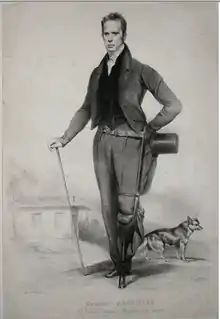 Lt. Col. John Beckwith's (infant) siblings; lost his leg in the Battle of Waterloo
Lt. Col. John Beckwith's (infant) siblings; lost his leg in the Battle of Waterloo
Military Officers (1816–1844)
 Charles Francis Norton died 1835; son-in-law of Sir Colin Campbell; brother-in-law of writer Caroline Norton[126]
Charles Francis Norton died 1835; son-in-law of Sir Colin Campbell; brother-in-law of writer Caroline Norton[126]
- Hon. William Cropton, died 1838, (2C) 85th Infantry; Brother to Baron Crofton, The Crofton Baronetcy, of Mohill in the County of County Leitrim (Plaque in St. Paul's)[127]
- Commander John George Dewar, HMS Rose. died 1830 (also plaque in St. Paul's church) [128][129] Plaque also in North Middleton churchyard
- John Thompson, Surgeon, HMS Saracen, died 1818
- Serg William George, 74th (Highland) Regiment of Foot, died 1828
- William Pepperell, Quarter Master of the 34th Regiment of Foot, died 1837
- Elizabeth Pepperell, grand daughter of William Pepperell through marriage, died 1775; wife of grandson William Pepperrell[69][130]
- Col Sgt. John Reilly, 64th (2nd Staffordshire) Regiment of Foot, died 1842
- John Ross, R.N., died 1844
- Lieut. Charles A. Ross, R.N., died 1828
- Lieut. James Philips, RN, died 1821
- Westmount, Capt. John 4 May 1816, Royal Staff Corps
Other
 John Gillespie, died 1772, 1st president of North British Society[131]
John Gillespie, died 1772, 1st president of North British Society[131] Ann Scott (died 1776), midwife, gravestone: "She will be greatly missed by the people of Halifax"
Ann Scott (died 1776), midwife, gravestone: "She will be greatly missed by the people of Halifax"
 William Bowie (merchant), died 1819, (killed by Richard John Uniacke Jr. in the last duel in Nova Scotia)[133]
William Bowie (merchant), died 1819, (killed by Richard John Uniacke Jr. in the last duel in Nova Scotia)[133]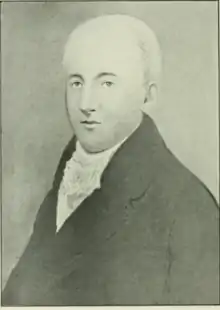 Hon James Fraser, died 1822
Hon James Fraser, died 1822 Rev. Roger Aitken (died 1825), missionary at Lunenburg for Society for the Propagation of the Gospel in Foreign Parts (SPG),[134][135] St. John's Anglican Church (Lunenburg)
Rev. Roger Aitken (died 1825), missionary at Lunenburg for Society for the Propagation of the Gospel in Foreign Parts (SPG),[134][135] St. John's Anglican Church (Lunenburg) John Lawson, died 1828, father of William Lawson, first president of the Bank of Nova Scotia
John Lawson, died 1828, father of William Lawson, first president of the Bank of Nova Scotia 2nd Elizabeth Lawson, died 1819, wife of John Lawson
2nd Elizabeth Lawson, died 1819, wife of John Lawson Peter McNab, namesake of McNabs Island
Peter McNab, namesake of McNabs Island Susan Cunard, wife of Samuel Cunard, died 1828
Susan Cunard, wife of Samuel Cunard, died 1828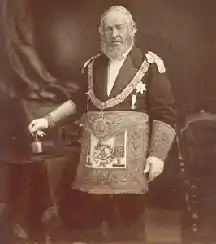 Brewer Alexander Keith's first wife Sarah Ann, died 1832, and the first two children with his second wife[136]
Brewer Alexander Keith's first wife Sarah Ann, died 1832, and the first two children with his second wife[136] Hon Stedman Rawlins, Slave/ Plantation Owner; died 1830, President of His Majesty's Council of the Island of St. Christopher
Hon Stedman Rawlins, Slave/ Plantation Owner; died 1830, President of His Majesty's Council of the Island of St. Christopher Rev Archibald Gray, died 1831, St. Matthew's United Church (Halifax) for 35 years
Rev Archibald Gray, died 1831, St. Matthew's United Church (Halifax) for 35 years.png.webp) John Albro, died 1839
John Albro, died 1839 Jonathan Prescott's son Samuel Thomas Prescott, died 1816 (St. Matthew's)
Jonathan Prescott's son Samuel Thomas Prescott, died 1816 (St. Matthew's)
- Mary Welsford, mother of Parker Welsford (Welsford-Parker Monument)[137]
- Charles Morris (1759–1831)
- William Annand, father of William Annand
- Dr. Samuel Head, first doctor born in Nova Scotia[138]
- Robert Collins (died 26 March 1812) and his wife Sarah (Wisdom) Collins (died 31 January 1812), namesake of Collins Grove, Dartmouth[139]
- James Gautier[140]
- Honorable Charles Hill (jurist) died 1825; brother-in-law of Thomas Cochran (Nova Scotia politician); director of the Shubenacadie Canal Company[141]
- John Thomas Twining, died 1832, son of John Thomas Twining[142]
- Phoebe Perkins, died 1820, wife of Rev. Cyrus Perkins, Rector of Annapolis, 1807–1817,[143][144][145][146][147]
Sculptor James Hay


There are various gravestones by stone carvers from London and the local region. Museum curator Deborah Trask asserts that one of the first stone sculptors, James Hay (1750–1842), likely made the gravestone of Richard Bulkeley's wife Mary. On one side Hay carved the angel Gabriel trumpeting, symbolic of the resurrection. The religious text: "In a moment, in a twinkling of an eye at the last trump; for the trumpet shall sound, and the dead shall be raised incorruptible, and we shall be changed" (1 Cor. 15:52). (The trumpeting motive is also on the gravestone of the Lawson children). On the opposite side of the gravestone is an image in the garden of Eden. The religious text: "For as in Adam all die, even so in Christ shall all be made alive." (1 Corinthians 15:22). The image is taken from "The Child's Guide" (London, 1725).[148][149][150]
Depictions in media
In Lucy Maud Montgomery's Anne of the Island, Anne moves to Kingsport (Halifax, Nova Scotia) on the mainland and enrols at Redmond (Dalhousie University).[151] She takes lodgings in an apartment that looks out over "Old St. John's Cemetery" – the Old Burying Ground:
They went in by the entrance gates, past the simple, massive, stone arch surmounted by the great lion of England.... They found themselves in a dim, cool, green place where winds were fond of purring. Up and down the long grassy aisles they wandered, reading the quaint, voluminous epitaphs, carved in an age that had more leisure than our own.[151]
The text goes into some depth about the gravestone carvings and styles:
Every citizen of Kingsport feels a thrill of possessive pride in Old St. John’s, for, if he be of any pretensions at all, he has an ancestor buried there, with a queer, crooked slab at his head, or else sprawling protectively over the grave, on which all the main facts of his history are recorded. For the most part no great art or skill was lavished on those old tombstones. The larger number are of roughly chiselled brown or gray native stone, and only in a few cases is there any attempt at ornamentation. Some are adorned with skull and cross-bones, and this grizzly decoration is frequently coupled with a cherub’s head. Many are prostrate and in ruins. Into almost all Time’s tooth has been gnawing, until some inscriptions have been completely effaced, and others can only be deciphered with difficulty. The graveyard is very full and very bowery, for it is surrounded and intersected by rows of elms and willows, beneath whose shade the sleepers must lie very dreamlessly, forever crooned to by the winds and leaves over them, and quite undisturbed by the clamor of traffic just beyond.[151]
See also
- Old Parish Burying Ground (Windsor, Nova Scotia)
- Fort Moncton – oldest British military gravestones in region
- Garrison Cemetery (Annapolis Royal, Nova Scotia)
- Royal Navy Burying Ground (Halifax, Nova Scotia)
- Hillcrest Cemetery (Lunenburg, Nova Scotia)
- St. John's Anglican Church (Lunenburg)
- Little Dutch (Deutsch) Church – St. George's Cemetery
References
- ↑ Burials until 1799
- ↑ St. Paul's Cemetery/ Old Burial Ground records (as transcribed in the Death, Burials & Probate of Nova Scotians)
- ↑ Williams, Paul B. (January 2003). "View of Raising the Dead: The Use of Osteo-Archaeology to Establish Identity at the Little Dutch Church, Halifax, Nova Scotia | Material Culture Review". Material Culture Review.
- ↑ 1763 Census indicates the Black population in Nova Scotia was 54 people.
- ↑ "Collections of the Nova Scotia Historical Society". Halifax, Nova Scotia Historical Society. September 9, 1880 – via Internet Archive.
- ↑ St. Paul's Cemetery/ Old Burial Ground records (as transcribed in the Death, Burials & Probate of Nova Scotians
- ↑ C. B. Fergusson, "A Documentary Study of the Establishment of the Negroes in Nova Scotia Between the War of 1812 and the Winning of Responsible Government, "Public Archives of Nova Scotia, Halifax, Publication no. 8,1948, p. 1.
- ↑ "Erasmus J. Philipps". skirret.com.
- ↑ Old Burying Ground National Historic Site of Canada. Canadian Register of Historic Places. Retrieved 13 April 2013.
- ↑ Old Burying Ground. Canadian Register of Historic Places. Retrieved 13 April 2013.
- 1 2 "Acadiensis; a quarterly devoted to the interests of the maritime provinces of Canada". St. John, N.B. p. 74. Retrieved 2017-03-10.
- 1 2 Bromley, J.; Bromley, D. (2015). Wellington's Men Remembered Volume 2: A Register of Memorials to Soldiers who Fought in the Peninsular War and at Waterloo- Volume II: M to Z. Vol. 2. Pen & Sword Books Limited. p. 296. ISBN 978-1473857698. Retrieved 2017-03-10.
- ↑ Halifax Gazette, July 1752
- ↑ Holder, Jean. Baptisms, Marriages and Burials, 1749–1768. St. Paul's Church, Halifax, Nova Scotia. Genealogical Association of Nova Scotia. Halifax, 1983, p. 30
- ↑ A sermon occasioned by the death of the Honorable Abigail Belcher, late consort of Jonathan Belcher, esq ... delivered at Halifax ... October 20, 1771 (Boston, Mass., 1772);
- ↑ Collections of the Nova Scotia Historical Society. Halifax. 1878.
- ↑ "Collections of the Nova Scotia Historical Society Vol. 1, p. 44". Halifax. 1878. Retrieved 2017-03-10.
- ↑ The location of both Charles Morris and Richard Bulkeley are unknown. Both Charles Morris and Richard Bulkeley have wives buried in the burial ground but they are not. Given the stature of both men, if they had tombstones, they would have been prominent. They both have a hatchment in the church. Given that everyone else who has a hatchment is buried in the church, the assumption is made Morris and Bulkeley are buried in the church. While a display inside the St. Paul's Church (Halifax) states that Bulkeley is buried in the crypt, according to J. Philip McAleer, author of A pictorial history of St. Paul's Anglican Church, Halifax, Nova Scotia, the evidence that Bulkeley was buried in the church is circumstantial. This circumstantial evidence rests on the fact that he helped establish the church and was an active member in it for 51 years. Also Bulkeley is reported to have had the largest funeral ceremony ever to be in Halifax up to that date. Further, his wife Mary Rous has a headstone in the St Paul's Church Cemetery, while Bulkeley does not. Rev Hill, however reports that Bulkeley's grave is marked by a rude stone in St. Paul's Church cemetery, presumably close to the gravestone of his wife Mary Rous. (See Collections of the Nova Scotia Historical Society, Vol. 2, p. 69)
- 1 2 "Julien Gwyn. Female Litigants before the Civil Courts of Nova Scotia, p. 341".
- 1 2 3 St. Paul Cemetery Burial Records
- ↑ (Signed at Halifax, 9 November 1761, by Jonathan Belcher, President of His Majesty's Council and Francis Muis, Chief of the La Have and witnessed by "P. Maillard, Priest missionnary of indians." (See Treaty
- ↑ NSARM RG-1, v. 188, "August 22, Nova Scotia Council Minutes" pp. 406–407, in Donald Marshall Jr. Defence Document Books, vol. 6, doc. 152; NSARM, RG-1 v. 430, doc. 21, sigogne to Sherbrooke, 1812-05-09", p. 2 in R v. Donald Marshall Jr. Defence Document Books, vol. 8, doc 212
- ↑ Another possibility is Chief Francis Alexis who is referenced in a 1771 document. A Chief Francis Jeremiah also signed the 1752 Treaty.
- ↑ The Mi'kmaq Nation and the Embodiment of Political Ideologies. SMU thesis.
- ↑ See the Nova Scotia Chronicle and Weekly Advertiser and Halifax Journal. Feb. 1781 (mic 7013)
- ↑ Archives, Nova Scotia (April 20, 2020). "Nova Scotia Archives – Mi'kmaq Holdings Resource Guide". Nova Scotia Archives.
- ↑ "Keith Mercer" (PDF).
- ↑ The Whitehall Evening Post Or London Intelligencer: 1755. 18. Jan. – 1. Jan. 1756. 1755. p. 2.
- ↑ The gentleman's magazine. 1755. p. 333.
- ↑ Osgoode Society for Canadian Legal History (2004). The Supreme Court of Nova Scotia, 1754–2004: From Imperial Bastion to Provincial Oracle. University of Toronto Press. p. 274. ISBN 978-0802080219.
- ↑ A sermon, occasioned by the death of Mrs. Margaret Green; consort of the late Honourable Benjamin Green, esq; delivered at Halifax, in the province of Nova-Scotia, February 1st, 1778 (Halifax, [1778?]).
- ↑ Jones, E. Alfred (1930). The loyalists of Massachusetts;their memorials, petitions and claims. London. p. 264.
- ↑ Sabine, Lorenzo (2009). Biographical Sketches of Loyalists of the American Revolution. Applewood Books. pp. 320–321. ISBN 978-1429019538.
- ↑ "Letter from David Phips to Colonel Jonathan Snelling regarding escort of Governor Hutchinson to Harvard Commencement, 1773 July 12 · Colonial North America Project at Harvard". colonialnorthamerica.library.harvard.edu. Archived from the original on 2018-02-07. Retrieved 2018-02-06.
- ↑ Chapin, Howard M. (1928). Privateering in King Georges̕ War, 1739–1748. E.A. Johnson Company. p. 86.
- ↑ "The American loyalists : or, Biographical sketches of adherents to the British crown in the war of the revolution, alphabetically arranged, with a preliminary historical essay". p. 625. Retrieved 2017-03-10.
- ↑ p. 19
- ↑ "Collections of the Nova Scotia Historical Society – image of brother Stephen Hall Binney". Halifax. 1878. Retrieved 2017-03-10.
- ↑ "Hon. Hibbert Newton Binney". Jo Edkins. Retrieved 2023-02-12.
- ↑ Public Archives of Nova Scotia, RG 20A, Volume 2, No. 1784–24
- ↑ Beck, J. Murray (1983). "Creighton, John". In Halpenny, Francess G (ed.). Dictionary of Canadian Biography. Vol. V (1801–1820) (online ed.). University of Toronto Press.
- ↑ Binney, Charles James Fox (1886). Genealogy of the Binney family in the United States. Albany, N. Y., J. Munsell's sons.
- ↑ Note Stephen Hall's older brother was also named Stephen Hall Binney (1749–1760), but he lived in Boston and died two days after his younger brother Stephen Hall was born in Halifax. The older brother Stephen is buried in King's Chapel, Boston.
- ↑ "The genealogical record of the Boggs family, the descendants of Ezekiel Boggs". FamilySearch.org. p. 16. Retrieved 2019-09-09.
- ↑ The United Service Magazine. Vol. 2. H. Colburn. 1835. p. 143.
- ↑ Marble, A.E. (1997). Surgeons, Smallpox and the Poor: A History of Medicine and Social Conditions in Nova Scotia, 1749–1799. McGill-Queen's University Press. p. 142. ISBN 978-0773516397. Retrieved 2017-03-10.
- ↑ "Lt. Charles Grant |".
- ↑ Flick, Alexander Clarence (September 9, 1901). "Loyalism in New York during the American revolution". New York : The Columbia University Press – via Internet Archive.
- ↑ "The American loyalists : or, Biographical sketches of adherents to the British crown in the war of the revolution, alphabetically arranged, with a preliminary historical essay". p. 174. Retrieved 2017-03-10.
- ↑ Shipton, C.K. (1995). New England Life in the Eighteenth Century: Representative Biographies from Sibley's Harvard Graduates. Belknap Press of Harvard University Press. p. 198. ISBN 978-0674612518. Retrieved 2017-03-10.
- ↑ "William Brattle, born 18 Apr 1706, chr. 21 Apr 1706, died Oct 1776". freepages.genealogy.rootsweb.ancestry.com. Retrieved 2017-03-10.
- ↑ James Murray (1713–1781) Letters of James Murray, Loyalist. There is also a Jacob Murray buried 1781.
- ↑ "Murray, James | NCpedia – Dictionary of North Carolina Biography". ncpedia.org. Retrieved 2017-03-10.
- ↑ "The American loyalists : or, Biographical sketches of adherents to the British crown in the war of the revolution, alphabetically arranged, with a preliminary historical essay". p. 711. Retrieved 2017-03-10.
- ↑ Father of Edward Winslow (loyalist) who was one of the founders of New Brunswick; his former home now belongs to the Mayflower House Museum
- ↑ Winslow's tombstone is inscribed in part "his fortune suffered shipwreck in the storm of civil war", the "civil war" being the American Revolution, American Patriots fighting American Loyalists.
- 1 2 3 4 5 6 7 8 9 10 Eaton, Arthur Wentworth Hamilton (1919). Chapters in the history of Halifax, Nova Scotia: Rhode Island Settlers in Hants County, Nova Scotia: Alexander McNutt the Colonizer. p. 786.
- ↑ "Winslow memorial : family records of the Winslows and their descendants in America, with the English ancestry as far as known. Kenelm Winslow ..." 1877. Retrieved 2017-03-10.
- ↑ "Collections of the Massachusetts Historical Society". 1792. Retrieved 2017-03-10.
- ↑ There were four judges of the Superior Court in Massachusetts at the time of the revolution. Foster Sr. was among the four judges who were Loyalists. See American Loyalists, p. 491
- ↑ Adams, J. (1965). Legal Papers of John Adams. Vol. 1. Belknap Press of Harvard University Press. Retrieved 2017-03-10.
- ↑ Hutchinson, T. (2010). The Diary and Letters of His Excellency Thomas Hutchinson. Vol. 1. Applewood Books. p. 342. ISBN 978-1429022996. Retrieved 2017-03-10.
- ↑ "The American loyalists : or, Biographical sketches of adherents to the British crown in the war of the revolution, alphabetically arranged, with a preliminary historical essay". p. 376. Retrieved 2017-03-10.
- ↑ grandchild of Mass. Gov. Thomas Hutchinson (governor); son Hon Foster Hutchinson Sr., died 1799; decedent of Anne Hutchinson
- ↑ Nichols, J. (1816). Gentleman's Magazine and Historical Chronicle. E. Cave. p. 179. Retrieved 2017-03-10.
- ↑ "The Loyalists of Massachusetts and the other side of the American Revolution". p. 177. Retrieved 2017-03-10.
- ↑ Another Grandchild of NS Gov. Paul Mascarene was William Handfield Snelling
- ↑ Nova Scotia. Courts; Congdon, F.T. (1890). A Digest of the Nova Scotia Common Law, Equity, Vice-admiralty and Election Reports: With Notes of Many Unreported Cases and of Cases Appealed to the Privy Council and Supreme Court of Canada from Nova Scotia. Containing Also Rules of Court, and an Index of the Imperial, Dominion and Nova Scotia Statutes, Referred to in the Reports, with the Notes and Comments Thereon. Carswell. ISBN 9780665007439. Retrieved 2017-03-10.
- 1 2 "The life of Sir William Pepperrell, bart., the only native of New England who was created a baronet during our connection with the mother country". p. 338. Retrieved 2017-03-10.
- ↑ According to a 1767 return, there were 54 Blacks in Halifax and area (See Archives)According to a 1783 report, 73 Blacks arrived in Halifax from New York. (Whitfield, p. 43) Of the 4007 Blacks that came to Nova Scotia in 1783, 69% (2775) were free, 35% (1423) were former British soldiers and 31% (1232) were slaves. While 41 slaves were sent to Dartmouth, none were sent to Halifax (Pachai, pp. 11–12). 550 Jamaican Maroons lived in Halifax for four years (1796–1800) (Pachai, p. 21). A return in December 1816 indicates there were 155 Blacks who migrated to Halifax during the War of 1812 (see Pachai, p. 23)
- ↑ The school for Black students was the only charitable school in Halifax for the next 26 years. Whites were not allowed to attend. (See Griffith)
- ↑ pp. 71–72
- ↑ Bradford, John (1788). An address to the inhabitants of New Brunswick, Nova Scotia, in North America. Hughes and Walsh ... ISBN 9780665206979.
- ↑ History of Methodism, p. 174
- ↑ Jack C. Whytock. The Huntingdonian Missionaries to Nova Scotia and New Brunswick, c. 1785–1792
- ↑ Kernaghan, Lois K. (1983). "Almon, William James". In Halpenny, Francess G (ed.). Dictionary of Canadian Biography. Vol. V (1801–1820) (online ed.). University of Toronto Press.
- ↑ Mackay, Donald C. (1987). "Etter, Benjamin". In Halpenny, Francess G (ed.). Dictionary of Canadian Biography. Vol. VI (1821–1835) (online ed.). University of Toronto Press.
- 1 2 3 4 McConnell, Brian (2016). "TLoyalists in the Old Burying Ground at Halifax" (PDF). United Empire Loyalists' Association of Canada. Retrieved 2019-09-09.
- ↑ Deputy Commissary General at Halifax
- ↑ Nova Scotia Historical Society, Halifax (1891). Collections of the Nova Scotia Historical Society. Nova Scotia Historical Society. p. 226. Retrieved 2017-03-10.
- ↑ "Theophilus Lillie". Revolutionary Characters.
- ↑ Halifax, Nova Scotia Historical Society (September 9, 1891). "Collections of the Nova Scotia Historical Society". Nova Scotia Historical Society. – via Google Books.
- ↑ Stark, James Henry (1972). The Loyalists of Massachusetts And the Other Side of the American Revolution. Library of Alexandria. ISBN 978-1465573919 – via Google Books.
- ↑ Kaiser, Leo M. (1984). Early American Latin verse, 1625–1825: an anthology. Bolchazy-Carducci Publishers. ISBN 978-0865160309 – via Google Books.
- ↑ Minot, Joseph Grafton (September 9, 1897). "A genealogical record of the Minot family in America and England". Boston, Mass. : Priv. print. – via Internet Archive.
- ↑ Sabine, Lorenzo (2009). Biographical Sketches of Loyalists of the American Revolution. Applewood Books. ISBN 978-1429019538 – via Google Books.
- ↑ "The American loyalists : or, Biographical sketches of adherents to the British crown in the war of the revolution, alphabetically arranged, with a preliminary historical essay". p. 650. Retrieved 2017-03-10.
- ↑ "The American loyalists : or, Biographical sketches of adherents to the British crown in the war of the revolution, alphabetically arranged, with a preliminary historical essay". p. 186. Retrieved 2017-03-10.
- ↑ Sutherland, D.A. (1987). "Hartshorne, Lawrence". In Halpenny, Francess G (ed.). Dictionary of Canadian Biography. Vol. VI (1821–1835) (online ed.). University of Toronto Press. Also see Hartshorne's portrait by Robert Field (painter)
- ↑ Book of Negros – Hawshorne
- ↑ Morris, Julie; Thorpe, Wendy L. (1987). "Debois, Sarah". In Halpenny, Francess G (ed.). Dictionary of Canadian Biography. Vol. VI (1821–1835) (online ed.). University of Toronto Press.
- ↑ "The genealogical record of the Boggs family, the descendants of Ezekiel Boggs". www.familysearch.org.
- ↑ "Annals, North British Society, Halifax, Nova Scotia : with portraits and biographical notes, 1768–1903". Retrieved 2017-03-10.
- ↑ "The American loyalists : or, Biographical sketches of adherents to the British crown in the war of the revolution, alphabetically arranged, with a preliminary historical essay | Geddes – Loyalist". Retrieved 2017-03-10.
- ↑ Fryer, Mary Beacock (1980). King's Men: The Soldier Founders of Ontario. ISBN 978-1554882052.
- ↑ "History of the county of Annapolis. p. 350". ourroots.ca. Retrieved 2017-03-10.
- ↑ "The Nova Scotia Calendar or an Almanack". myheritage.com. Retrieved 2019-09-09.
- ↑ War Office, Great Britain (1798). A List of the Officers of the Army and of the Corps of Royal Marines (forty-sixth ed.). G.E. Eyre and W. Spottiswoode. p. 114.
- ↑ Prince Edward was his commander and etched on his stone: "This Stone Sacred to the Memory of Lieut. Chales Thomas of His Majesty's Royal Fusilier Regiment who departed this Life on the 16 August 1797, Aged 24 years; is placed as a Testimony of His Friendship and Esteem by Lieut. General His Royal Highness Prince Edward his Colonel."
- ↑ Halifax Acadian Recorder, April 15, 1920
- ↑ Clarke, J.S.; Jones, S.; Jones, J. (1799). The Naval Chronicle. Vol. 1. J. Gold. Retrieved 2017-03-10.
- ↑ "James Brace Sutherland (died 1798)". threedecks.org. Retrieved 2017-03-10.
- ↑ History of the Royal Sappers and Miners [microform] : from the formation of the corps in March 1772 to the date when its designation was changed to that of Royal Engineers in October 1856. ISBN 9780665167669. Retrieved 2017-03-10.
- ↑ "Westmacott, Capt. John | Biographical Dictionary of Architects in Canada". dictionaryofarchitectsincanada.org. Retrieved 2017-03-10.
- ↑ The Gentleman's Magazine. Vol. 119. 1816. p. 566. Retrieved 2017-03-10.
- ↑ True Stories from Nova Scotia's Past By Dianne Marshall
- ↑ Harris. The Church of St. Paul in Halifax, p. 230
- ↑ "Captain Sir Thomas Ussher (1779–1848) | Art UKArt UK | Discover Artworks Captain Sir Thomas Ussher (1779–1848)". artuk.org. Retrieved 2017-03-10.
- ↑ Archives, Nova Scotia (April 20, 2020). "Nova Scotia Archives – Nova Scotia Historical Newspapers". Nova Scotia Archives.
- ↑ Great Britain. War Office (1821). A List of the Officers of the Army and of the Corps of Royal Marines. G.E. Eyre and W. Spottiswoode. p. 230.
- ↑ Authority (1818). The Army List for September 1818.
- ↑ "Fleiger, John Henry". Biographical Dictionary of Architects in Canada.
- ↑ "The Naval Chronicle, for 1813: Containing a General and Biographical History of the Royal Navy of the United Kingdom; with a Variety of Original Papers on Nautical Subjects. Under the Guidance of Several Literary and Professional Men. Vol. XXIX. (from January to June.)". Retrieved 2017-03-10.
- ↑ "Richard Smith 104th Regiment of Foot | Graveside Project". 1812veterans.ca. Retrieved 2017-03-10.
- ↑ "Two tough War of 1812 vets to be lauded at Halifax cemetery | The Chronicle Herald". thechronicleherald.ca. Archived from the original on 2017-05-10. Retrieved 2017-03-10.
- ↑ "The 104th (New Brunswick) Regiment of Foot in the War of 1812 John R. Grodzinski". gooselane.com. Archived from the original on 2016-10-18. Retrieved 2017-03-10.
- ↑ Burke, J. (1838). A Genealogical and Heraldic History of the Commoners of Great Britain and Ireland, Enjoying Territorial Possessions Or High Official Rank: But Uninvested with Heritable Honours. Vol. 4. Henry Colburn. p. 435. Retrieved 2017-03-10.
- ↑ "The Royal military calendar, or Army service and commission book. Containing the services and progress of promotion of the generals, lieutenant-generals, major-generals, colonels, lieutenant-colonels, and majors of the army, according to seniority: with details of the principal military events of the last century". Retrieved 2017-03-10.
- ↑ "History of the county of Lunenburg". 1895. p. 325. Retrieved 2017-03-10.
- ↑ Deborah Trask. Putting the War of 1812 to Rest. Royal Nova Scotia Historical Society Journal. Vol. 18, 2015, p. 49
- ↑ Philippart, John (1820). The Royal Military Calendar, Or Army Service and Commission Book. A. J. Valpy. p. 362.
- ↑ "Portrait of James Orde".
- ↑ Sylvanus Urban (1850). The Gentleman's Magazine. p. 93.
- ↑ (99th Regiment, 1811–18: Nova Scotia, New Brunswick.); Johnson Thornhill Born Tempemore, Tipperary Served in 99th Foot Regiment
- ↑ James, Charles (1820). A Collection of the Charges, Opinions, and Sentences of General Courts Martial: As Published by Authority; from the Year 1795 to the Present Time; Intended to Serve as an Appendix to Tytler's Treatise on Military Law, and Forming a Book of Cases and References; with a Copious Index. London: T. Egerton. pp. 477–478.
- ↑ p. 79 – Plaque in St. Paul's Church, Halifax, Nova Scotia
- ↑ Acadian Recorder 21 April 1838 Vol. 26 No. 16 Nova Scotia Historical Newspapers
- ↑ "John George Dewar d. Yes, date unknown: MacFarlane Clan & Families Genealogy". www.clanmacfarlanegenealogy.info.
- ↑ Jack, David Russell (September 8, 2019). "Acadiensis; a quarterly devoted to the interests of the maritime provinces of Canada". [St. John, N.B.] – via Internet Archive.
- ↑ "The Pepperrells in America". Retrieved 2017-03-10.
- ↑ "Annals, North British Society, Halifax, Nova Scotia : with portraits and biographical notes, 1768–1903". Retrieved 2017-03-10.
- ↑ "Cochran-Inglis family of Halifax by Eaton, Arthur Wentworth Hamilton, 1899". 1899. Retrieved 2017-03-10.
- ↑ "Annals, North British Society, Halifax, Nova Scotia : with portraits and biographical notes, 1768–1903 | Image and Bio of Bowie". Retrieved 2017-03-10.
- ↑ DesBrisay, M.B. (1895). History of the County of Lunenburg. W. Briggs. p. 86. Retrieved 2017-03-10.
- ↑ Note he was the grandfather of Charles Aitkens (see here)
- ↑ Note both children are also named on their father's grave stone in Camp Hill Cemetery.
- ↑ Inauguration of the Welsford and Parker Monument at Halifax, on Tuesday, 17th July, 1860 [microform] : committee, H. Pryor ... [et al.]. 1860. p. 16. ISBN 9780665562877. Retrieved 2017-03-10.
- ↑ Pryke, K. G. (1988). "Head, Samuel". In Halpenny, Francess G (ed.). Dictionary of Canadian Biography. Vol. VII (1836–1850) (online ed.). University of Toronto Press.
- ↑ "Untitled". brookhousepress.ca. Retrieved 2017-03-10.
- ↑ Nova Scotia Historical Society, Halifax (1891). Collections of the Nova Scotia Historical Society. Nova Scotia Historical Society. pp. 1–152. Retrieved 2017-03-10.
- ↑ Cahill, J.B. (1987). "Hill, Charles". In Halpenny, Francess G (ed.). Dictionary of Canadian Biography. Vol. VI (1821–1835) (online ed.). University of Toronto Press.
- ↑ Fingard, Judith (1985). "Twining, John Thomas". In Halpenny, Francess G (ed.). Dictionary of Canadian Biography. Vol. VIII (1851–1860) (online ed.). University of Toronto Press.
- ↑ Rev. Perkins was born at Horton, Nova Scotia, and studied at Kings College, Windsor, Nova Scotia to become a missionary for the Society for the Propagation of the Gospel. He died inTorbay, Devon, England. (See Nova Scotia Archives
- ↑ "A Geography and History of the County of Digby, Nova Scotia". Retrieved 2017-03-10.
- ↑ Howley, William (1817-02-21). A sermon [on Matth. xxviii, 18–20] preached ... February 21, 1817, by William, bishop of London. p. 45.
- ↑ Archives, Nova Scotia (April 17, 2003). "Nova Scotia Archives – Notman Studio, Halifax, N.S." novascotia.ca.
- ↑ Perkins, Caroline Erickson; Derby, Perley (February 26, 1914). "The Descendants of Edward Perkins of New Haven, Conn". Rochester, NY: [s.n.] – via Internet Archive.
- ↑ Deborah Trask, p. 61
- ↑ "Markers". [Worcester?, Mass.] : Association for Gravestone Studies. September 9, 1980 – via Internet Archive.
- ↑ Ford, Paul Leicester (September 9, 1897). "The New-England primer; a history of its origin and development; with a reprint of the unique copy of the earliest known edition and many facsimile illustrations and reproductions". New York : Printed for Dodd, Mead and co. – via Internet Archive.
- 1 2 3 "Anne of the Island, by Lucy Maud Montgomery". www.gutenberg.org. Retrieved 2016-11-20.
External links
- Old Burying Ground at Find a Grave
- The treatment of Halifax's poor house dead during the nineteenth and twentieth centuries By Cynthia Simpson. 2011
- Memorials at St. Paul's Church. Acadiensis. Vol. 5, p. 57
- The (Old St. Paul's) Burying Ground
- Halifax's Old Burying Ground
- Old Burying Ground Foundation Archived 2021-06-01 at the Wayback Machine
- List of People buried in cemetery
- Finda a Grave – list of gravesite with photos
- Honours Thesis. St. Mary's University
- Loyalists in the Old Burying Ground
- Nova Scotia Museum
- Stark, James Henry (1972). The Loyalists of Massachusetts And the Other Side of the American Revolution. Library of Alexandria. ISBN 978-1465573919.
